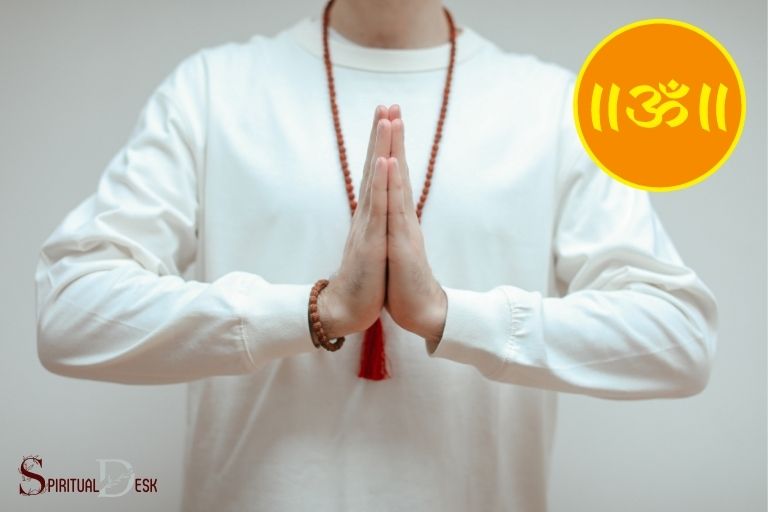What is the Spiritual Meaning of Namaste in Hindi? Respect
The spiritual meaning of Namaste in Hindi is “I bow to the divine in you” or “The divine in me honors the divine in you”.
Namaste is a traditional salutation and gesture of respect in Indian culture, especially in Hinduism.
It is derived from two Sanskrit words: “namas,” which means “bowing” or “obeisance,” and “te,” which means “to you.”
Namaste signifies the recognition and acknowledgment of the divine spirit within oneself and others.
This greeting transcends beyond a mere formality, as it represents the celebration of our shared humanity and spirituality.
In essence, Namaste is a powerful and spiritual way of connecting with others, acknowledging the inherent divinity in each individual. It encourages us to recognize the interdependence and unity of all living beings.
By employing the Namaste gesture, we pay homage to the divine within and promote an atmosphere of mutual respect and humility.
This timeless salutation is not only a cultural tradition but also an expression of spiritual values that are deeply enshrined in the Indian way of life.
7 Aspects: Spiritual Meaning of Namaste in Hindi
| Spiritual Aspect | Meaning of Namaste in Hindi |
|---|---|
| Divine Spark | Recognizing the divine energy or Atman in the other person, acknowledging their inner spirit. |
| Mutual Respect | Expressing respect and gratitude towards the other person, regardless of their social or spiritual status. |
| Connection | Signifying the connection of two individual souls, transcending physical and mental boundaries. |
| Union of Opposites | The gesture represents a balanced union of opposites, symbolizing unity and harmony. |
| Humility | Demonstrating one’s humility and acceptance of the other person as a fellow seeker of truth. |
| Non-Verbal Greeting | Conveying a traditional and respectful greeting without any verbal communication. |
| Presence of God | Reminding oneself and the other person of the omnipresent and omnipotent nature of the divine. |
Key Takeaway

Five Facts About the spiritual meaning of namaste in hindi
Introduction: Understanding The Spiritual Meaning Of Namaste In Hindi
Namaste is a popular greeting in india, and it holds great cultural and spiritual significance. It’s a way of acknowledging the divine spark within each individual and recognizing that we are all connected. We’ll explore the spiritual meaning of namaste in hindi and its etymology.
What is the spiritual meaning of namaste in hindi?
- Namaste is a traditional indian greeting that is commonly used in the hindi language.
- The word “namaste” is made up of two parts – “nama” and “te”.
- The word “nama” means “to bow” or “to pay homage”, while “te” is a reference to “you” or “yourself”.
- Therefore, the spiritual meaning of namaste in hindi is “i bow to the divine in you” or “i honor the divine spark within you.”
The Etymology Of “Namaste”
- The use of the word namaste goes back to ancient indian texts, such as the vedas and the upanishads.
- It’s a combination of two sanskrit words – namah (to bow) and te (you).
- Namaste is often expressed with a slight bow and with palms pressed together in front of the chest.
- This gesture is known as the anjali mudra and represents the connection between the right and left sides of the body, as well as the union of the individual self with the universal consciousness.
Understanding The Cultural Significance Of Namaste In India
- Namaste is an important aspect of indian culture and is used not just as a greeting but also as a form of farewell, gratitude, and respect.
- It’s a way of acknowledging the divinity in others and showing them reverence and humility.
- Namaste is often used in spiritual practices such as yoga and meditation as a way of centering oneself and connecting with the divine within.
- It’s also an important part of hindu rituals and ceremonies, where it’s used to invoke the blessings of the divine.
Namaste is a powerful way of recognizing the divinity within ourselves and others. Its spiritual meaning in hindi represents the bowing down to the divine spark within each individual and recognizing the interconnection between all living beings.
The etymology of the word itself reveals the deep roots of this ancient practice in indian culture and spirituality.
The Spiritual Significance Of Namaste In Hindi Culture
Namaste is a sanskrit word that has now become universal. In hindi culture, namaste is not just a casual greeting, but it holds deep spiritual significance. It is a traditional form of greeting that is said with folded hands, bowed head, and a warm smile.
We will explore the spiritual meaning of namaste in hindi culture and the deep-rooted symbolism of this ancient salutation.
Namaste As A Greeting
Namaste is a combination of two words, “namah” and “te”. It means “i bow to you” or “i honor you”.
Namaste is the most common way of greeting someone in traditional indian culture, and it’s a way of showing respect and reverence.
It’s a beautiful way of acknowledging the divine presence within every human being, regardless of their caste, color, or creed.
The Significance Of The Gesture
The gesture of namaste is equally important as the word itself. It involves bringing both hands together in front of the heart chakra, with fingers pointing upwards. The palms are pressed together firmly, and the eyes are closed while making the gesture.
This position is symbolic of the opening and balancing of the heart chakra, which is the center of love, compassion, and connection with the divine. The gesture of namaste is a way of connecting with one’s own soul and the soul of the other person.
The Concept Of “Namaskar” And Its Variations Across India
In hindi culture, the concept of namaskar is similar to namaste, but there are variations in the way it’s practiced across different regions of india.
- Pranama: It is a common practice in west bengal, where people touch the feet of elders as a mark of reverence and seek their blessings.
- Namaskaram: In south india, namaskaram is a form of greeting where people hold their hands together and bow with a slight inclination of the head.
- Namaskar: In north india, namaskar is a popular way of greeting, where people fold their hands together and slightly bow their head.
- Sashtang pranam: In some parts of india, like maharashtra, sashtang pranam is a form of paying respect where people lie flat on the ground and touch the feet of elders as a mark of reverence.
Namaste is not just a greeting but a way of life for many indians. The spiritual significance of namaste lies in its deeper meaning and the practice of acknowledging the divine light within every person.
Through this simple act of greeting, we can connect with our own soul and the soul of others, and spread love, harmony, and peace in the world.
The Spiritual And Symbolic Meaning Of Namaste In Hindi
Namaste is a popular term that you may have heard being used in hindu and yoga communities. But what exactly does the term mean?
Namaste is a common greeting used in india and nepal, and it’s more than just a simple hello. It has a deep spiritual and symbolic significance that is rooted in hindu traditions.
Introducing The Spiritual Significance Of Namaste
Namaste is derived from the sanskrit language, and it is made up of two words – “nama” and “te. ” Together, they represent the belief that there is a divine spark in each of us, and it is this spark that connects us all.
Namaste is therefore more than just a greeting – it is an acknowledgment of the divinity within each of us.
The Meaning Of “Nama” And “Te”
The word “nama” means to bow, whereas “te” means to you. Therefore, namaste translates to “i bow to you” or “i honor the divinity within you. ”
Namaste is primarily used as a sign of respect and greeting in indian culture, and it is used to greet people of all ages, genders, and social standing.
Sage Patanjali’S Interpretation Of Namaste
Sage patanjali, the author of the yoga sutras, interpreted namaste as a way of acknowledging the soul in one another.
He believed that by acknowledging the divinity in each other, we can overcome our ego and connect with others on a deeper level.
In this way, namaste is not just a physical gesture but also a way of experiencing and connecting with others on a spiritual level.
The Symbolic Nature Of Namaste As A Hindu Tradition
Namaste has a deep symbolic nature in hindu tradition. The hands are brought together in front of the chest, fingers pointing upward, with the palms touching one another. This gesture is known as “anjali mudra” and is often used in prayer and meditation.
It represents the joining of the left-hand side of the brain (which represents logic and reason) with the right-hand side (which represents emotion and intuition).
This joining of the two sides is believed to bring balance to the mind and body, creating harmony within oneself and with others.
Namaste is more than just a hello, but a way of acknowledging the divinity within each of us. It is a way of connecting with others on a spiritual level, recognizing the soul in one another.
Namaste is deeply symbolic and represents the joining of logic and emotion, creating balance and harmony within oneself and with others.
Namaste And Yoga: The Spiritual Significance
Namaste is a term commonly associated with yoga, but what is the spiritual meaning behind this hindi tradition?
Namaste is derived from two sanskrit words, ‘namah’ which means ‘bow’ or ‘adoration’, and ‘te’ which means ‘you’. Essentially, namaste is a gesture of respect and greeting, acknowledging the divinity within all beings.
We explore the spiritual significance of namaste in hindi, with a particular focus on the connection between yoga and hinduism. We’ll also explore how this simple yet profound gesture helps one connect with their spiritual self.
Namaste As A Core Concept In Yoga
Namaste is a commonly used word in the yoga community, often used as a greeting or farewell. However, it is more than just a simple gesture; it is a core concept of yoga.
The spiritual meaning of namaste goes beyond just a physical movement, as it encompasses the mind, body, and soul.
When one offers namaste, they acknowledge the divine energy within themselves and others, promoting a sense of peace, love, and unity.
Here are a few key points to remember about namaste in yoga:
- Namaste is not just a physical gesture; it is a spiritual practice.
- It is a way of acknowledging the divine within oneself and others.
- Namaste is a gesture of respect and gratitude, promoting a sense of unity and oneness.
The Connection Between Yoga And Hinduism
Yoga is deeply rooted in hinduism, dating back over 5,000 years. This ancient practice is a spiritual discipline that aims to cultivate a deeper connection between mind, body, and soul.
In hinduism, the practice of yoga is seen as a means of reaching enlightenment and liberation.
Here are some key points regarding the connection between yoga and hinduism:
- Yoga originated in india over 5,000 years ago.
- It is deeply rooted in hinduism and other eastern religions.
- The practice of yoga is considered a means of achieving enlightenment and liberation.
How Namaste Helps Connect With Spiritual Self
Namaste is a powerful spiritual practice that helps to connect with one’s inner self. It promotes a sense of mindfulness and awareness, enabling us to connect with the divine energy within and around us.
Here are a few key points to remember about how namaste helps us connect with our spiritual self:
- Namaste is a practice of mindfulness and awareness.
- It promotes a sense of inner peace and calm.
- Namaste enables us to connect with the divine energy within and around us.
Namaste is a simple yet powerful practice that promotes a sense of unity, peace, and mindfulness. It is not just a physical gesture but a spiritual practice deeply rooted in hinduism and yoga philosophy.
By acknowledging the divine within ourselves and others, we can cultivate a deeper connection with our spiritual self, promoting healing, growth, and transformation.
Namaste In The Modern Era: Its Global Significance
Namaste is a traditional indian greeting that has been used for centuries. In hindi culture, it is a combination of two sanskrit words, “namah” and “te,” meaning “i bow to you” or “i honor you. ” However, the spiritual meaning of namaste goes beyond its literal definition.
It is a way of acknowledging the divine in each individual and recognizing the oneness of all things.
In recent years, namaste has gained global popularity and prominence. In this blog post, we’ll explore the modern significance of namaste and its role in different cultures.
We will focus on the subheading: namaste in the modern era: its global significance.
The Globalization Of Yoga And Namaste
In recent years, yoga has exploded in popularity worldwide, with millions of people practicing it as a form of physical exercise and mental relaxation.
This surge in interest has led to the globalization of yoga and its accompanying customs, including the use of namaste.
Today, namaste is used as a greeting in many yoga studios and wellness centers worldwide.
Some key points on the globalization of yoga and namaste are:
- Yoga has become a multi-billion dollar industry, with millions of people across the world practicing it.
- The popularity of yoga has led to the adoption of many of its customs, including the use of namaste as a greeting.
- Namaste’s popularity has spread beyond yoga and is now used in many other contexts as a sign of respect and acknowledgement.
The Emergence Of Namaste As A Popular Greeting
Namaste’s emergence as a popular greeting in the modern era can be attributed to a variety of factors.
One major factor is the rise of globalization and cross-cultural exchange. As people from all over the world begin communicating and interacting more frequently, the use of namaste has become more widespread.
Some key points on the emergence of namaste as a popular greeting are:
- Namaste has become a popular greeting in many cultures due to the rise of globalization and cross-cultural exchange.
- The spread of yoga and mindfulness practices has also contributed to the use of namaste in various contexts.
- In some places, namaste has become a trendy alternative to traditional greetings like “hello” and “goodbye.”
How Different Cultures Use Namaste Today
Namaste is a word that has taken on different meanings and connotations in different cultures. In india, it is still used primarily as a sign of respect and reverence.
However, in other parts of the world, its meaning has expanded to include greetings, farewells, and other social interactions.
Some key points on how different cultures use namaste today are:
- In western countries, namaste is often used as a greeting or a farewell, similar to how “hello” and “goodbye” are used.
- In some cultures, namaste is seen as a sign of spiritual or religious affiliation.
- In others, namaste is simply a polite way of acknowledging someone.
Namaste has transcended its cultural origins and become a globally recognizable symbol of respect and acknowledgement.
As yoga and mindfulness practices continue to grow in popularity, it’s likely that the use of namaste will continue to expand to new contexts and cultures.
The Future And Evolution Of Namaste
The spiritual meaning of namaste in hindi is deep and rooted in indian culture. Namaste is a customary way of respecting elders, saluting deities and paying homage to one’s inner self.
However, as we move towards a technologically advanced world, the future and evolution of namaste is inevitable.
Namaste Vs. Covid-19: A New Age Greeting
Covid-19 pandemic has affected almost all aspects of our lives, and greeting others is no exception.
The handshake, which was once a common way of greeting people, has given way to social distancing norms, paving the way for new-age greetings.
Namaste, which has always been a safe and hygienic way of greeting others, has become more popular than ever.
Some of the key points to consider are:
- Namaste can be done without physical contact, ensuring safety during pandemics.
- It is a gesture that acknowledges the other person’s presence and respects them.
- Namaste requires a bit of self-discipline and the ability to control one’s emotions.
How Namaste Is Changing With Time
Namaste has always been a versatile gesture that can convey a plethora of emotions, such as respect, gratitude, and acknowledgement. But as we move towards a more globalized world, namaste has started changing with time.
Key points to consider are:
- Namaste has become popular outside of india, especially in yoga and spiritual communities.
- People are adapting namaste to their cultural and linguistic backgrounds, creating a unique fusion.
- Namaste is no longer limited to face-to-face greeting, but it has become a part of digital communication.
The Future Of Namaste Beyond National Boundaries
Namaste has always been a part of indian culture, but with the world becoming a global village, namaste has started transcending national borders. As namaste becomes more popular around the world, it will continue to evolve with time.
Some of the key points to consider are:
- Namaste will continue to evolve as it adapts to new cultures and traditions.
- It has the potential to become a universal gesture, bringing people from different cultures together.
- Namaste can become a part of global communication and more people will start using it in digital communication.
Namaste is more than just a greeting; it is a way of life. The future and evolution of namaste are promising, as it continues to change, adapt and evolve with time. As we move towards a digital age, namaste’s potential is limitless.
It has become more than a greeting or salutation; it is a universal gesture of respect, acknowledgement and gratitude.
FAQ About What Is The Spiritual Meaning Of Namaste In Hindi
What Does Namaste Mean In Hindi?
Namaste is a greeting expressing respect and acknowledgment of the other person’s soul.
What Is The Spiritual Significance Of Namaste?
Namaste represents recognizing the divine spark in oneself and acknowledging it in others.
Is Namaste Only Used In India?
Namaste is a common greeting not only in india but also in other south asian countries.
How Do You Say Namaste?
Namaste is pronounced as “nah-muh-stay” with an emphasis on the second syllable.
Can Non-Hindus Use Namaste?
Yes, namaste can be used by anyone irrespective of their religion or cultural background.
Conclusion
Namaste, a spiritual gesture that originated in india, holds a profound meaning that transcends beyond cultural and religious boundaries.
It is a salutation that acknowledges the divine spark within every being and fosters a deeper connection with oneself and the world.
The spiritual significance of namaste is rooted in ancient hindu philosophy, where the soul is regarded as the ultimate reality, and the physical body is merely a temporary vessel.
By bowing to another person and uttering namaste, one honours the divine essence within the other person and recognizes the interconnectivity of all things in the universe.
As we immerse ourselves in the fast-paced world, taking a moment to practise namaste can bring a sense of calmness and mindfulness that centres us in the present moment.
In today’s multicultural world, learning and embracing the spiritual meaning of namaste can promote unity and respect for diversity.
May the universal message of namaste inspire us to live with compassion, kindness and gratitude towards all beings.






